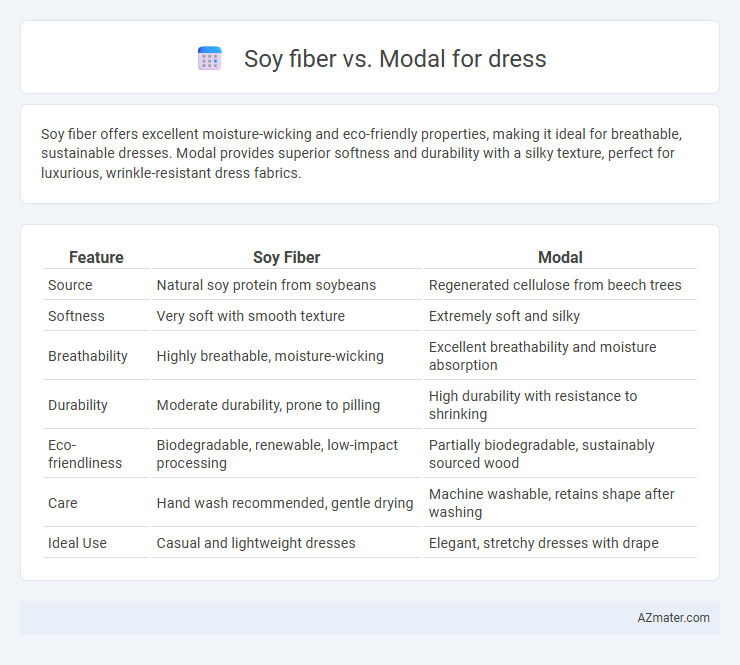Soy fiber offers excellent moisture-wicking and eco-friendly properties, making it ideal for breathable, sustainable dresses. Modal provides superior softness and durability with a silky texture, perfect for luxurious, wrinkle-resistant dress fabrics.
Table of Comparison
| Feature | Soy Fiber | Modal |
|---|---|---|
| Source | Natural soy protein from soybeans | Regenerated cellulose from beech trees |
| Softness | Very soft with smooth texture | Extremely soft and silky |
| Breathability | Highly breathable, moisture-wicking | Excellent breathability and moisture absorption |
| Durability | Moderate durability, prone to pilling | High durability with resistance to shrinking |
| Eco-friendliness | Biodegradable, renewable, low-impact processing | Partially biodegradable, sustainably sourced wood |
| Care | Hand wash recommended, gentle drying | Machine washable, retains shape after washing |
| Ideal Use | Casual and lightweight dresses | Elegant, stretchy dresses with drape |
Introduction to Soy Fiber and Modal
Soy fiber, derived from soybean protein, offers a sustainable and biodegradable fabric option characterized by its soft texture and excellent moisture absorption, making it ideal for comfortable and breathable dresses. Modal, a semi-synthetic fiber made from beech tree cellulose, is known for its silky feel, high durability, and resistance to shrinkage, providing a smooth and elegant appearance in dress fabrics. Both fibers blend eco-friendly qualities with refined aesthetics, catering to the growing demand for sustainable and luxurious dress materials.
Key Properties of Soy Fiber
Soy fiber, derived from soy protein, offers excellent moisture absorption and biodegradability, making it an eco-friendly choice for dresses. It provides a soft, silky texture with natural UV protection and antibacterials properties that help reduce odor, enhancing comfort during extended wear. Soy fiber's durability and good elasticity contribute to wrinkle resistance, ensuring dresses maintain their shape and appearance over time.
Key Properties of Modal
Modal fabric, derived from beech tree pulp, boasts exceptional softness, breathability, and moisture-wicking properties, making it ideal for dresses requiring comfort and durability. Its high tensile strength and resistance to shrinkage and pilling ensure longevity and a smooth, silky texture even after multiple washes. Unlike soy fiber, modal maintains vibrant color retention and drapes elegantly, enhancing the overall aesthetic and wearability of dresses.
Environmental Impact: Soy Fiber vs Modal
Soy fiber, derived from soybean protein, offers a renewable and biodegradable option with lower water consumption and reduced chemical use compared to synthetic fibers. Modal, made from beech tree cellulose, is also biodegradable but often involves significant water and energy usage during production, although some manufacturers adopt closed-loop processes to minimize environmental harm. When comparing environmental impact, soy fiber generally presents a smaller ecological footprint due to its agricultural origins and less intensive processing requirements.
Comfort and Skin Feel Comparison
Soy fiber offers a smooth, silky texture with excellent moisture-wicking properties, making it highly breathable and comfortable for dress fabrics. Modal, derived from beech trees, provides a soft, luxurious feel with superior drape and resistance to shrinkage, enhancing the garment's longevity and comfort against the skin. Both fibers excel in skin-friendliness, but soy fiber is particularly favored for its natural antibacterial qualities, while modal stands out for its silky softness and durability.
Durability and Longevity in Dresses
Soy fiber offers natural strength and resistance to pilling, contributing to moderate durability in dresses. Modal, derived from beech trees, is known for its exceptional durability and ability to maintain softness and shape even after multiple wash cycles. Dresses made from modal typically have longer longevity due to their resistance to wear, shrinkage, and fading compared to soy fiber fabrics.
Moisture Absorption and Breathability
Soy fiber exhibits excellent moisture absorption capabilities, absorbing up to 30% of its weight in water, which helps keep the skin dry and comfortable. Modal, derived from beech trees, offers superior breathability with its fine, smooth fibers that allow better air circulation and reduce heat retention in dresses. Both fibers enhance comfort, but Modal's breathability often makes it more suitable for warm-weather dresses, while soy fiber excels in moisture management for active wear.
Ease of Care and Maintenance
Soy fiber dresses are highly breathable and naturally resist wrinkles, making them easy to care for with simple machine washing and low-temperature drying. Modal fabric offers superior softness and durability, with excellent resistance to shrinking and fading, allowing for hassle-free maintenance through gentle washing cycles and cold water. Both fibers require minimal ironing, but soy fiber's natural elasticity provides a slight edge in wrinkle recovery for effortless wear.
Style, Colors, and Finishes
Soy fiber offers a soft, natural texture that drapes elegantly, ideal for casual and eco-friendly dress styles, while modal provides a smooth, silky finish suited for more polished and sophisticated looks. Soy fabric typically comes in earth tones and muted colors that emphasize its organic origin, whereas modal is available in a broader spectrum of vibrant colors with excellent color retention. Modal dresses often feature a lustrous sheen and wrinkle resistance that enhances their refined finish, contrasting with soy fiber's matte, breathable surface that supports a relaxed aesthetic.
Which is Better for Dresses: Soy Fiber or Modal?
Soy fiber offers exceptional softness and breathability, making it ideal for comfortable, eco-friendly dresses that are gentle on sensitive skin. Modal provides excellent durability, moisture-wicking properties, and a smooth, silky texture, ensuring dresses maintain their shape and vibrant color after multiple washes. For dress fabric, modal is often better due to its strength and color retention, while soy fiber suits those prioritizing sustainability and a natural feel.

Infographic: Soy fiber vs Modal for Dress
 azmater.com
azmater.com